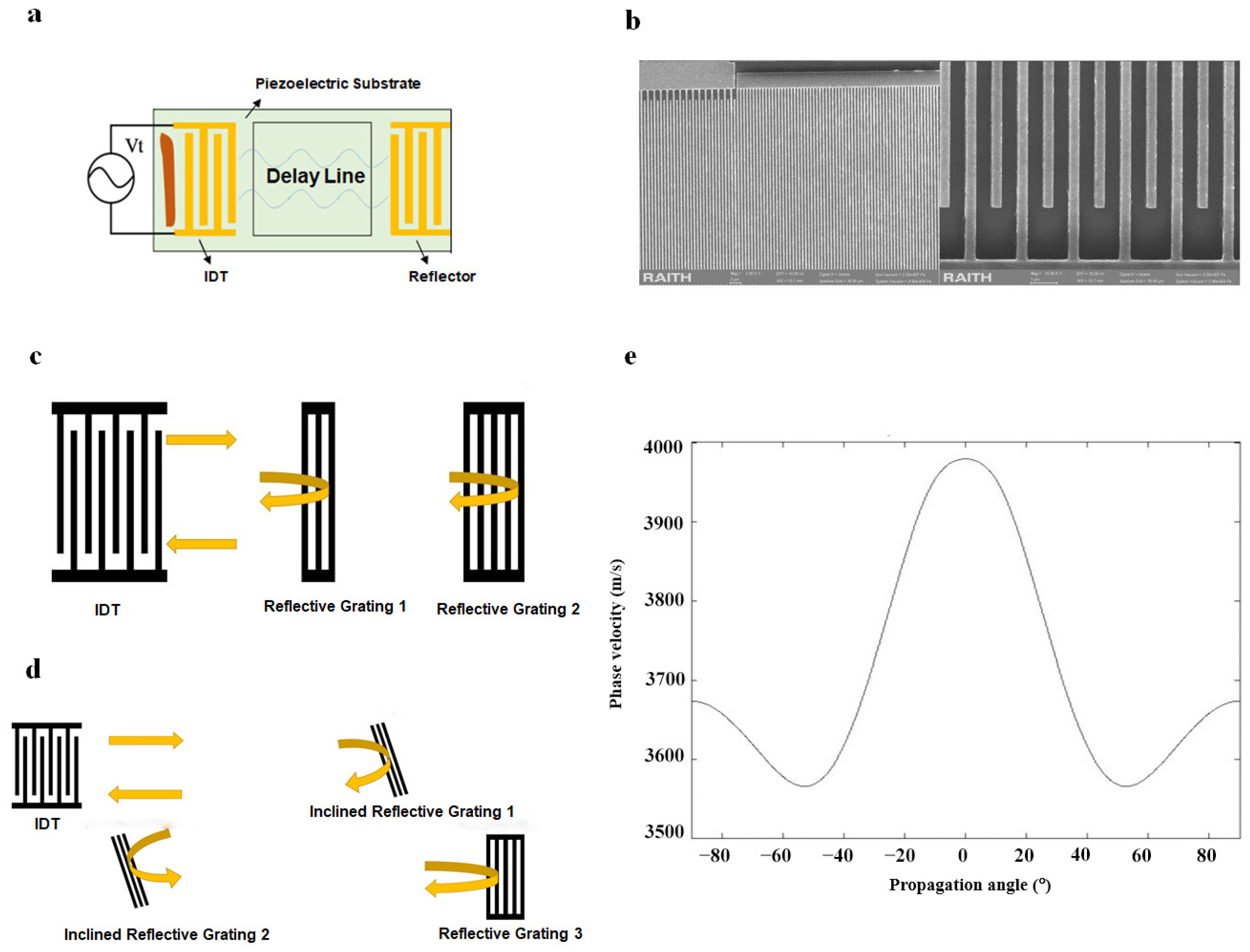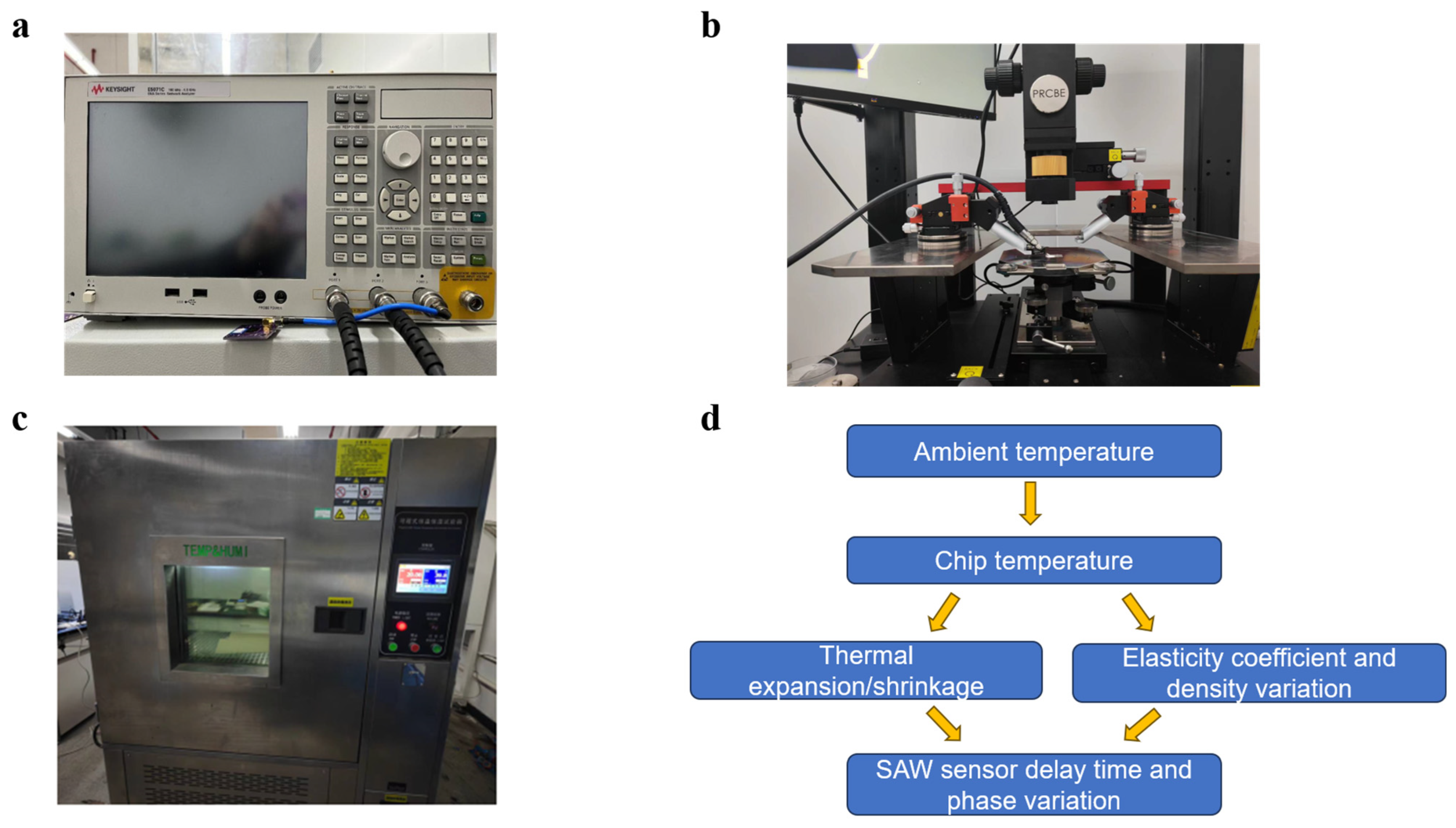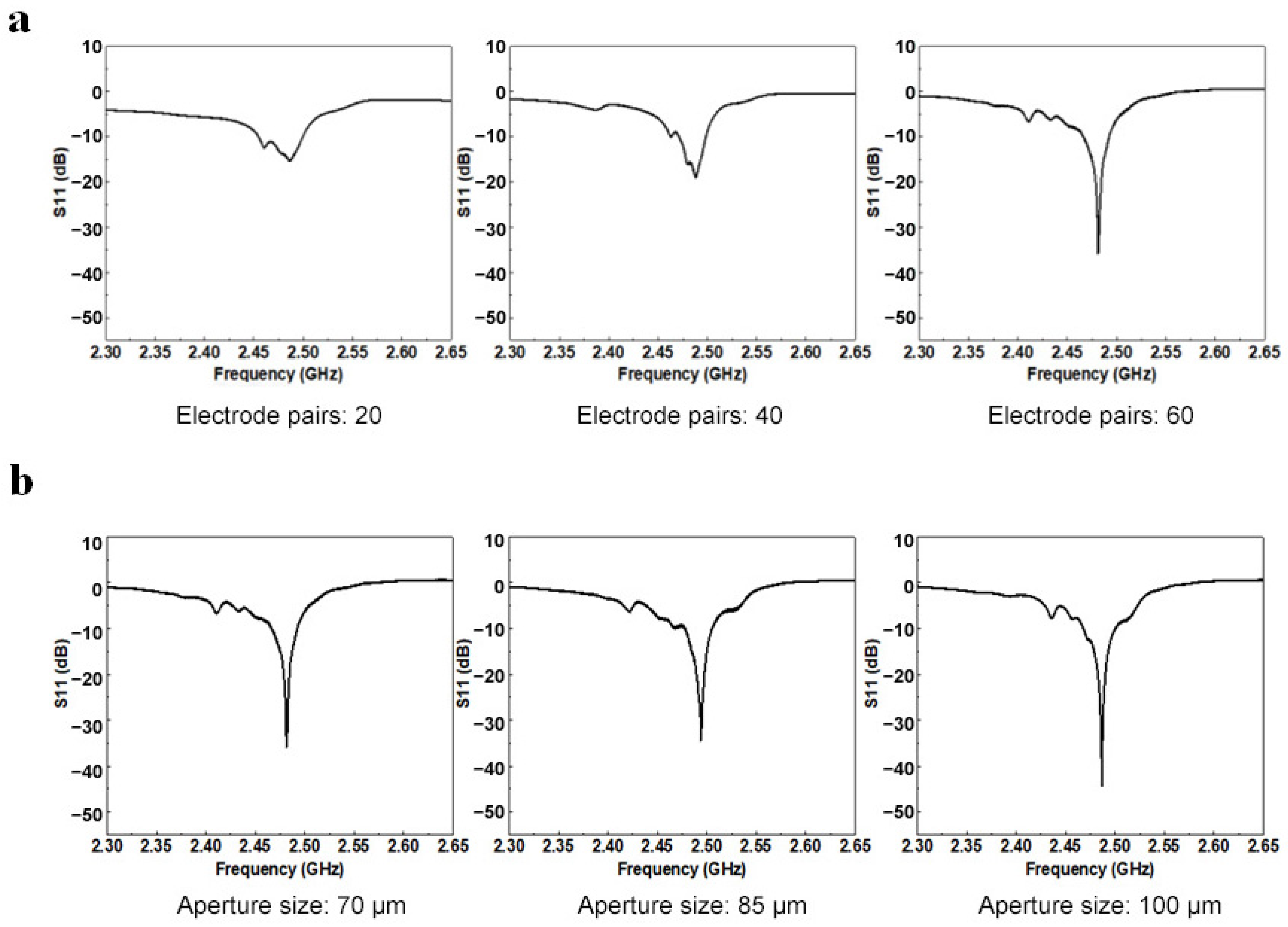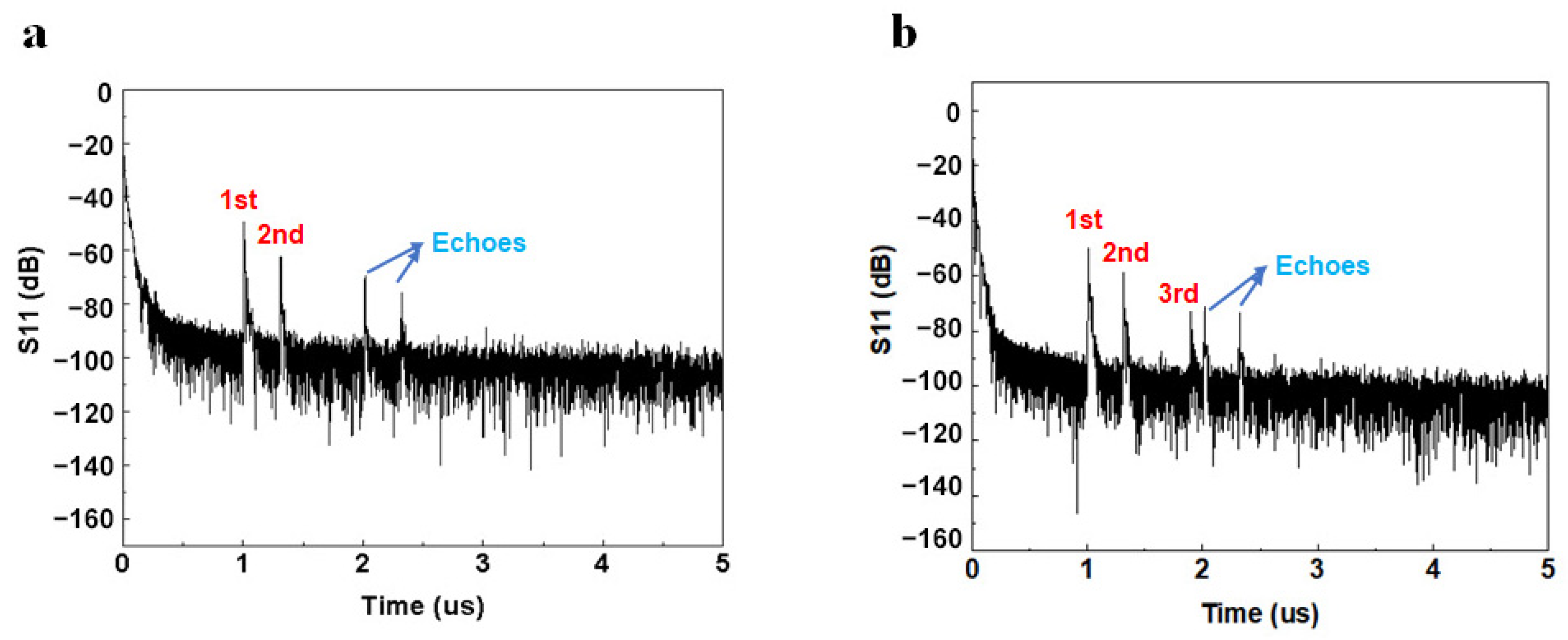Ultra-High Frequency Surface Acoustic Wave Sensors for Temperature Detection
Abstract
:1. Introduction
2. Experiment and Methods
2.1. SAW Delay Line Sensor Fabrication
2.2. Numerical Simulation of Electrode Properties
2.3. Device Performance and Temperature Test
3. Results and Discussion
3.1. Performance Testing
3.2. Temperature Sensitivity Testing
4. Conclusions
Author Contributions
Funding
Data Availability Statement
Conflicts of Interest
References
- Machin, J.; Tucker, D.; Pearce, J.V. Pearce, A comprehensive survey of thermoelectric homogeneity of commonly used thermocouple types. Meas. Sci. Technol. 2018, 29, 067002. [Google Scholar] [CrossRef]
- Cabrita, A.A.C.M.; Mendes, R.; Quintela, D.A. Thermistor based, low velocity isothermal, air flow sensor. Meas. Sci. Technol. 2016, 27, 035307. [Google Scholar] [CrossRef]
- Hendawy, N.; McQuaid, H.; Mariotti, D.; Maguire, P. Continuous gas temperature measurement of cold plasma jets containing microdroplets, using a focussed spot IR sensor. Plasma Sources Sci. Technol. 2020, 29, 085010. [Google Scholar] [CrossRef]
- Keränen, K.; Mäkinen, J.-T.; Korhonen, P.; Juntunen, E.; Heikkinen, V.; Mäkelä, J. Infrared temperature sensor system for mobile devices. Sens. Actuators A Phys. 2010, 158, 161–167. [Google Scholar] [CrossRef]
- Mandal, D.; Banerjee, S. Surface Acoustic Wave (SAW) Sensors: Physics, Materials, and Applications. Sensors 2022, 22, 820. [Google Scholar] [CrossRef] [PubMed]
- Liu, B.; Chen, X.; Cai, H.; Ali, M.M.; Tian, X.; Tao, L.; Yang, Y.; Ren, T. Surface acoustic wave devices for sensor applications*. J. Semicond. 2016, 37, 021001. [Google Scholar] [CrossRef]
- Seifert, F.; Bulst, W.-E.; Ruppel, C. Mechanical sensors based on surface acoustic waves. Sens. Actuators A Phys. 1994, 44, 231–239. [Google Scholar] [CrossRef]
- Maboudian, R. Impact of Surface Acoustic Wave Sensors on Chemical Sciences. ACS Sens. 2020, 5, 2973–2974. [Google Scholar] [CrossRef]
- Tigli, O.; Zaghloul, M.E. A Novel Saw Device in CMOS: Design, Modeling, and Fabrication. IEEE Sens. J. 2007, 7, 219–227. [Google Scholar] [CrossRef]
- Huang, Y.; Das, P.K.; Bhethanabotla, V.R. Surface acoustic waves in biosensing applications. Sens. Actuators Rep. 2021, 3, 100041. [Google Scholar] [CrossRef]
- Pohl, A. A review of wireless SAW sensors. IEEE Trans. Ultrason. Ferroelectr. Freq. Control 2000, 47, 317–332. [Google Scholar] [CrossRef] [PubMed]
- Ahrend, U.; Aleksy, M.; Berning, M.; Gebhardt, J.; Mendoza, F.; Schulz, D. Sensors as the Basis for Digitalization: New Approaches in Instrumentation, IoT-concepts, and 5G. Internet Things 2021, 15, 100406. [Google Scholar] [CrossRef]
- Plessky, V.P.; Reindl, L.M. Review on SAW RFID tags. IEEE Trans. Ultrason. Ferroelectr. Freq. Control 2010, 57, 654–668. [Google Scholar] [CrossRef] [PubMed]
- Plessky, V.; Lamothe, M. Ultra-wide-band SAW RFID/sensors. In Proceedings of the 2014 European Frequency and Time Forum (EFTF), Neuchâtel, Switzerland, 23–26 June 2014; pp. 16–23. [Google Scholar] [CrossRef]
- Malocha, D.C.; Gallagher, M.; Fisher, B.; Humphries, J.; Gallagher, D.; Kozlovski, N. A Passive Wireless Multi-Sensor SAW Technology Device and System Perspectives. Sensors 2013, 13, 5897–5922. [Google Scholar] [CrossRef] [PubMed]
- Bulst, W.-E.; Fischerauer, G.; Reindl, L. State of the art in wireless sensing with surface acoustic waves. In Proceedings of the 24th Annual Conference of the IEEE Industrial Electronics Society (Cat. No.98CH36200), Aachen, Germany, 31 August 1998; Volume 4, pp. 2391–2396. [Google Scholar] [CrossRef]
- Wang, W.; Lee, K.; Woo, I.; Park, I.; Yang, S. Optimal design on SAW sensor for wireless pressure measurement based on reflective delay line. Sens. Actuators A Phys. 2007, 139, 2–6. [Google Scholar] [CrossRef]
- Kang, A.; Zhang, C.; Ji, X.; Han, T.; Li, R.; Li, X. SAW-RFID enabled temperature sensor. Sens. Actuators A Phys. 2013, 201, 105–113. [Google Scholar] [CrossRef]
- Garbacz, H.; Wieciński, P.; Adamczyk-Cieślak, B.; Mizera, J.; Kurzydłowski, K. Studies of aluminium coatings deposited by vacuum evaporation and magnetron sputtering. J. Microsc. 2010, 237, 475–480. [Google Scholar] [CrossRef] [PubMed]
- Kelly, P.J.; Arnell, R.D. Magnetron sputtering: A review of recent developments and applications. Vacuum 2000, 56, 159–172. [Google Scholar] [CrossRef]
- Tokimatsu, K.; Tamura, S.; Kojima, H. Effects of Multiple Modes on Rayleigh Wave Dispersion Characteristics. J. Geotech. Eng. 1992, 118, 1529–1543. [Google Scholar] [CrossRef]
- Dickinson, E.J.; Ekström, H.; Fontes, E. COMSOL Multiphysics®: Finite element software for electrochemical analysis. A mini-review. Electrochem. Commun. 2014, 40, 71–74. [Google Scholar] [CrossRef]
- Manbachi, A.; Cobbold, R.S.C. Development and Application of Piezoelectric Materials for Ultrasound Generation and Detection. Ultrasound 2011, 19, 187–196. [Google Scholar] [CrossRef]
- Han, B.-Y.; Zhao, B.; Sun, R.-H. Research on Motion Control and Wafer-Centering Algorithm of Wafer-Handling Robot in Semiconductor Manufacturing. Sensors 2023, 23, 8502. [Google Scholar] [CrossRef] [PubMed]
- Binder, A.; Fachberger, R. Wireless SAW Temperature Sensor System for High-Speed High-Voltage Motors. IEEE Sens. J. 2011, 11, 966–970. [Google Scholar] [CrossRef]







| Key Parameters | Au | Pt | Ag | Al |
|---|---|---|---|---|
| Young’s modulus E (GPa) | 70 | 168 | 83 | 70.3 |
| Poisson’s ratio μ | 0.44 | 0.38 | 0.34 | 0.345 |
| Density r (g/cm3) | 19.93 | 21.45 | 10.5 | 2.7 |
Disclaimer/Publisher’s Note: The statements, opinions and data contained in all publications are solely those of the individual author(s) and contributor(s) and not of MDPI and/or the editor(s). MDPI and/or the editor(s) disclaim responsibility for any injury to people or property resulting from any ideas, methods, instructions or products referred to in the content. |
© 2023 by the authors. Licensee MDPI, Basel, Switzerland. This article is an open access article distributed under the terms and conditions of the Creative Commons Attribution (CC BY) license (https://creativecommons.org/licenses/by/4.0/).
Share and Cite
Dong, Q.; Yang, Q.; Liu, X.; Hu, S.; Nie, W.; Jiang, Z.; Fan, X.; Luo, J.; Tao, R.; Fu, C. Ultra-High Frequency Surface Acoustic Wave Sensors for Temperature Detection. Micromachines 2024, 15, 135. https://doi.org/10.3390/mi15010135
Dong Q, Yang Q, Liu X, Hu S, Nie W, Jiang Z, Fan X, Luo J, Tao R, Fu C. Ultra-High Frequency Surface Acoustic Wave Sensors for Temperature Detection. Micromachines. 2024; 15(1):135. https://doi.org/10.3390/mi15010135
Chicago/Turabian StyleDong, Qi, Qutong Yang, Xiaoyang Liu, Shenghe Hu, Wenzhe Nie, Zhao Jiang, Xiaoming Fan, Jingting Luo, Ran Tao, and Chen Fu. 2024. "Ultra-High Frequency Surface Acoustic Wave Sensors for Temperature Detection" Micromachines 15, no. 1: 135. https://doi.org/10.3390/mi15010135






